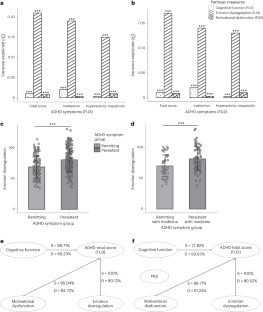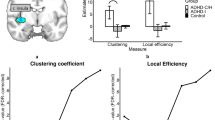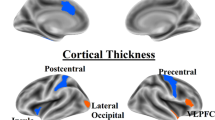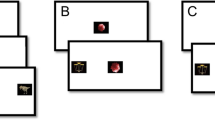Abstract
Emotion dysregulation is common in attention deficit hyperactivity disorder (ADHD), which is known to be clinically heterogeneous. However, it remains unclear whether emotion dysregulation represents a neuropsychological pathway to ADHD. Here, using a large population-based cohort (n = 6,053), we show that emotion dysregulation was associated with ADHD symptoms (partial eta2 = 0.21) and this persisted after controlling for the cognitive and motivational deficits. Emotion dysregulation mediated the association between smaller surface area of the right pars orbitalis and greater ADHD symptoms at 1-year follow-up, indicating an emotion pathway for ADHD. This pathway was associated with immune responses by both transcriptomic analyses and white blood cell markers. In an independent clinical sample for ADHD (n = 672), the emotion pathway improved the case/control classification accuracy. These findings suggest that emotion dysregulation is a core symptom and route to ADHD, which may not respond to the current pharmacological treatments for ADHD.
This is a preview of subscription content, access via your institution
Access options
Subscribe to this journal
Receive 12 digital issues and online access to articles
$59.00 per year
only $4.92 per issue
Buy this article
- Purchase on Springer Link
- Instant access to full article PDF
Prices may be subject to local taxes which are calculated during checkout



Similar content being viewed by others
Data availability
Data are publicly released on an annual basis through the NIMH Data Archive (NDA, https://nda.nih.gov/abcd). The ABCD Study data are openly available to qualified researchers for free. Access can be requested at https://nda.nih.gov/abcd/request-access. The ABCD data used in this report came from Data Release 5.0 (https://doi.org/10.15154/8873-zj65). An NDA study has been created for the data used in this report under the digital object identifier https://doi.org/10.15154/nfsk-9n15. ADHD-200 data are available from a dedicated database. Summary statistics of GWAS for ADHD is publicly available and can be downloaded from https://www.med.unc.edu/pgc/download-results/adhd/. The transcriptomic data were downloaded from the Allen Human Brain Atlas (AHBA, https://human.brain-map.org/). The multi-tissue cell-type markers data can be downloaded from the Cell Marker2.0 database (http://bio-bigdata.hrbmu.edu.cn/CellMarker/index.html). Source data are provided with this paper.
Code availability
Code for the replication of analyses conducted in the manuscript can be retrieved at https://github.com/DanTouHaHa/ER-in-ADHD.
References
Willcutt, E. G. The prevalence of DSM-IV attention-deficit/hyperactivity disorder: a meta-analytic review. Neurotherapeutics 9, 490–499 (2012).
Sonuga-Barke, E. J. S. et al. Annual research review: perspectives on progress in ADHD science—from characterization to cause. J. Child Psychol. Psychiatry 64, 506–532 (2023).
Norman, L. J. et al. Longitudinal trajectories of childhood and adolescent attention deficit hyperactivity disorder diagnoses in three cohorts. EClinicalMedicine 60, 102021 (2023).
Sonuga-Barke, E. J. The dual pathway model of AD/HD: an elaboration of neuro-developmental characteristics. Neurosci. Biobehav. Rev. 27, 593–604 (2003).
Shen, C. et al. Neural correlates of the dual-pathway model for ADHD in adolescents. Am. J. Psychiatry 177, 844–854 (2020).
Stevens, M. C., Pearlson, G. D., Calhoun, V. D. & Bessette, K. L. Functional neuroimaging evidence for distinct neurobiological pathways in attention-deficit/hyperactivity disorder. Biol. Psychiatry Cogn. Neurosci. Neuroimaging 3, 675–685 (2018).
Nigg, J. T., Willcutt, E. G., Doyle, A. E. & Sonuga-Barke, E. J. Causal heterogeneity in attention-deficit/hyperactivity disorder: do we need neuropsychologically impaired subtypes? Biol. Psychiatry 57, 1224–1230 (2005).
van Lieshout, M., Luman, M., Buitelaar, J., Rommelse, N. N. & Oosterlaan, J. Does neurocognitive functioning predict future or persistence of ADHD? A systematic review. Clin. Psychol. Rev. 33, 539–560 (2013).
Nigg, J. T., Karalunas, S. L., Feczko, E. & Fair, D. A. Toward a revised nosology for attention-deficit/hyperactivity disorder heterogeneity. Biol. Psychiatry Cogn. Neurosci. Neuroimaging 5, 726–737 (2020).
Shaw, P., Stringaris, A., Nigg, J. & Leibenluft, E. Emotion dysregulation in attention deficit hyperactivity disorder. Am. J. Psychiatry 171, 276–293 (2014).
Nigg, J. T., Goldsmith, H. H. & Sachek, J. Temperament and attention deficit hyperactivity disorder: the development of a multiple pathway model. J. Clin. Child Adolesc. Psychol. 33, 42–53 (2004).
Braver, T. S. et al. Mechanisms of motivation–cognition interaction: challenges and opportunities. Cogn. Affect. Behav. Neurosci. 14, 443–472 (2014).
Beheshti, A., Chavanon, M. L. & Christiansen, H. Emotion dysregulation in adults with attention deficit hyperactivity disorder: a meta-analysis. BMC Psychiatry 20, 120 (2020).
Graziano, P. A. & Garcia, A. Attention-deficit hyperactivity disorder and children’s emotion dysregulation: a meta-analysis. Clin. Psychol. Rev. 46, 106–123 (2016).
Pozzi, M. et al. Adverse drug events related to mood and emotion in paediatric patients treated for ADHD: a meta-analysis. J. Affect. Disorders 238, 161–178 (2018).
Luo, Y., Weibman, D., Halperin, J. M. & Li, X. A review of heterogeneity in attention deficit/hyperactivity disorder (ADHD). Front. Hum. Neurosci. 13, 42 (2019).
Christiansen, H., Hirsch, O., Albrecht, B. & Chavanon, M. L. Attention-deficit/hyperactivity disorder (ADHD) and emotion regulation over the life span. Curr. Psychiatry Rep. 21, 17 (2019).
Ahmed, S. P., Bittencourt-Hewitt, A. & Sebastian, C. L. Neurocognitive bases of emotion regulation development in adolescence. Dev. Cogn. Neurosci. 15, 11–25 (2015).
Rosch, K. S. & Hawk, L. W. Jr. The effects of performance-based rewards on neurophysiological correlates of stimulus, error, and feedback processing in children with ADHD. Psychophysiology 50, 1157–1173 (2013).
Frank, D. W. et al. Emotion regulation: quantitative meta-analysis of functional activation and deactivation. Neurosci. Biobehav. Rev. 45, 202–211 (2014).
Samea, F. et al. Brain alterations in children/adolescents with ADHD revisited: a neuroimaging meta-analysis of 96 structural and functional studies. Neurosci. Biobehav. Rev. 100, 1–8 (2019).
Barch, D. M. et al. Demographic and mental health assessments in the adolescent brain and cognitive development study: updates and age-related trajectories. Dev. Cogn. Neurosci. 52, 101031 (2021).
Achenbach, T., McConaughy, S., Ivanova, M. & Rescorla, L. Manual for the ASEBA Brief Problem Monitor™ (BPM) (ASEBA, 2011).
Bernanke, J. et al. Structural brain measures among children with and without ADHD in the Adolescent Brain and Cognitive Development Study cohort: a cross-sectional US population-based study. Lancet Psychiatry 9, 222–231 (2022).
Chen, D. et al. Brain signatures during reward anticipation predict persistent attention-deficit/hyperactivity disorder symptoms. J. Am. Acad. Child. Adoles. Psychiatry 61, 1050–1061 (2022).
Chen, J. W. et al. Best practice guidelines for propensity score methods in medical research: consideration on theory, implementation, and reporting. A review. Arthroscopy 38, 632–642 (2022).
Kanehisa, M. & Goto, S. KEGG: Kyoto Encyclopedia of Genes and Genomes. Nucleic Acids Res. 28, 27–30 (2000).
Viering, T. et al. Emotion dysregulation and integration of emotion-related brain networks affect intraindividual change in ADHD severity throughout late adolescence. NeuroImage 245, 118729 (2021).
Sjöwall, D., Roth, L., Lindqvist, S. & Thorell, L. B. Multiple deficits in ADHD: executive dysfunction, delay aversion, reaction time variability, and emotional deficits. J. Child Psychol. Psychiatry 54, 619–627 (2013).
Castellanos, F. X., Sonuga-Barke, E. J. S., Milham, M. P. & Tannock, R. Characterizing cognition in ADHD: beyond executive dysfunction. Trends Cogn. Sci. 10, 117–123 (2006).
Barkley, R. A. & Fischer, M. The unique contribution of emotional impulsiveness to impairment in major life activities in hyperactive children as adults. J. Am. Acad. Child Adolesc. Psychiatry 49, 503–513 (2010).
Mitul, A. M. et al. Methylphenidate enhances working memory by modulating discrete frontal and parietal lobe regions in the human brain. J. Neurosci. 20, RC65 (2000).
Volkow, N. D. et al. Methylphenidate-elicited dopamine increases in ventral striatum are associated with long-term symptom improvement in adults with attention deficit hyperactivity disorder. J. Neurosci. 32, 841–849 (2012).
Suzer Gamli, I. & Tahiroglu, A. Y. Six months methylphenidate treatment improves emotion dysregulation in adolescents with attention deficit/hyperactivity disorder: a prospective study. Neuropsychiatric Dis. Treat. 14, 1329–1337 (2018).
Kanarik, M., Grimm, O., Mota, N. R., Reif, A. & Harro, J. ADHD co-morbidities: a review of implication of gene × environment effects with dopamine-related genes. Neurosci. Biobehav. Rev. 139, 104757 (2022).
Cisler, J. M. & Olatunji, B. O. Emotion regulation and anxiety disorders. Curr. Psychiatry Rep. 14, 182–187 (2012).
Petruso, F., Giff, A. E., Milano, B. A., De Rossi, M. M. & Saccaro, L. F. Inflammation and emotion regulation: a narrative review of evidence and mechanisms in emotion dysregulation disorders. Neuronal Signal. 7, NS20220077 (2023).
D’Acquisto, F. Affective immunology: where emotions and the immune response converge. Dialogues Clin. Neurosci. 19, 9–19 (2017).
Moriarity, D. P. et al. A systematic review of associations between emotion regulation characteristics and inflammation. Neurosci. Biobehav. Rev. 150, 105162 (2023).
Morrens, M. et al. The relationship between immune and cognitive dysfunction in mood and psychotic disorder: a systematic review and a meta-analysis. Mol. Psychiatry 27, 3237–3246 (2022).
Eddy, P., Wertheim, E. H., Hale, M. W. & Wright, B. J. A systematic review and revised meta-analysis of the effort–reward imbalance model of workplace stress and hypothalamic–pituitary–adrenal axis measures of stress. Psychosom. Med. 85, 450–460 (2023).
Skott, E. et al. Effects of a synbiotic on symptoms, and daily functioning in attention deficit hyperactivity disorder—a double-blind randomized controlled trial. Brain Behav. Immunity 89, 9–19 (2020).
De Picker, L. J. et al. TSPO PET brain inflammation imaging: a transdiagnostic systematic review and meta-analysis of 156 case-control studies. Brain Behav. Immun. 113, 415–431 (2023).
Rubia, K. ‘Cool’ inferior frontostriatal dysfunction in attention-deficit/hyperactivity disorder versus ‘hot’ ventromedial orbitofrontal-limbic dysfunction in conduct disorder: a review. Biol. Psychiatry 69, e69–e87 (2011).
Belyk, M., Brown, S., Lim, J. & Kotz, S. A. Convergence of semantics and emotional expression within the IFG pars orbitalis. Neuroimage 156, 240–248 (2017).
Vaidya, C. J. et al. Altered neural substrates of cognitive control in childhood ADHD: evidence from functional magnetic resonance imaging. Am. J. Psychiatry 162, 1605–1613 (2005).
Posner, J. et al. Dissociable attentional and affective circuits in medication-naïve children with attention-deficit/hyperactivity disorder. Psychiatry Res. Neuroimaging 213, 24–30 (2013).
Ochsner, K. N. & Gross, J. J. The cognitive control of emotion. Trends Cogn. Sci. 9, 242–249 (2005).
Achenbach, T. M. Achenbach System of Empirically Based Assessment (ASEBA). in Encyclopedia of Clinical Neuropsychology 1–7 (Springer, 2017).
Achenbach, T. & Rescorla, L. Manual for the ASEBA School-Age Forms and Profiles: An Integrated System of Multi-informant Assessment (ASEBA, 2001).
Nakamura, B. J., Ebesutani, C., Bernstein, A. & Chorpita, B. F. A psychometric analysis of the Child Behavior Checklist DSM-Oriented Scales. J. Psychopathol. Behav. Assess. 31, 178–189 (2009).
Van Meter, A. R. et al. The stability and persistence of symptoms in childhood-onset ADHD. Eur. Child Adolesc. Psychiatry 33, 1163–1170 (2023).
Bleck, T. P., Nowinski, C. J., Gershon, R. & Koroshetz, W. J. What is the NIH Toolbox, and what will it mean to neurology? Neurology 80, 874–875 (2013).
Acker, W. A computerized approach to psychological screening—the Bexley-Maudsley Automated Psychological Screening and the Bexley-Maudsley Category Sorting Test. Int. J. Man Mach. Stud. 17, 361–369 (1982).
Carver, C. S. & White, T. L. Behavioral inhibition, behavioral activation, and affective responses to impending reward and punishment: the BIS/BAS Scales. J. Pers. Soc. Psychol. 67, 319–333 (1994).
Serrano-Ibáñez, E. R., Ramírez-Maestre, C., Esteve, R. & López-Martínez, A. E. The behavioural inhibition system, behavioural activation system and experiential avoidance as explanatory variables of comorbid chronic pain and posttraumatic stress symptoms. Eur. J. Psychotraumatol. 10, 1581013 (2019).
Weiss, N. H., Gratz, K. L. & Lavender, J. M. Factor structure and initial validation of a multidimensional measure of difficulties in the regulation of positive emotions: the DERS-Positive. Behav. Modif. 39, 431–453 (2015).
Bunford, N. et al. The Difficulties in Emotion Regulation Scale-Parent Report: a psychometric investigation examining adolescents with and without ADHD. Assessment 27, 921–940 (2020).
Gratz, K. L. & Roemer, L. Multidimensional Assessment of Emotion Regulation and Dysregulation: development, factor structure, and initial validation of the Difficulties in Emotion Regulation Scale. J. Psychopathol. Behav. Assess. 26, 41–54 (2004).
Guzmán-González, M., Mendoza-Llanos, R., Garrido-Rojas, L., Barrientos, J. & Urzúa, A. Cut-off points of the Difficulties in Emotion Regulation Scale for the Chilean population. Revista Medica de Chile 148, 644–652 (2020).
Fischl, B. FreeSurfer. Neuroimage 62, 774–781 (2012).
Desikan, R. S. et al. An automated labeling system for subdividing the human cerebral cortex on MRI scans into gyral based regions of interest. Neuroimage 31, 968–980 (2006).
Hagler, D. J. et al. Image processing and analysis methods for the Adolescent Brain Cognitive Development Study. Neuroimage 202, 116091 (2019).
Bethlehem, R. A. I. et al. Brain charts for the human lifespan. Nature 604, 525–533 (2022).
Hawrylycz, M. J. et al. An anatomically comprehensive atlas of the adult human brain transcriptome. Nature 489, 391–399 (2012).
Arnatkevic̆iūtė, A., Fulcher, B. D. & Fornito, A. A practical guide to linking brain-wide gene expression and neuroimaging data. Neuroimage 189, 353–367 (2019).
Noble, K. G. et al. Family income, parental education and brain structure in children and adolescents. Nat. Neurosci. 18, 773–778 (2015).
Bates, D., Mächler, M., Bolker, B. & Walker, S. Fitting linear mixed-effects models using lme4. J. Stat. Softw. https://doi.org/10.18637/jss.v067.i01 (2015).
Scutari, M. Learning Bayesian networks with the bnlearn R package. J. Stat. Softw. https://doi.org/10.18637/jss.v035.i03 (2010).
Ho, D., Imai, K., King, G. & Stuart, E. A. MatchIt: nonparametric preprocessing for parametric causal inference. J. Stat. Softw. https://doi.org/10.18637/jss.v042.i08 (2011).
Hoogman, M. et al. Brain imaging of the cortex in ADHD: a coordinated analysis of large-scale clinical and population-based samples. Am. J. Psychiatry 176, 531–542 (2019).
Bao, H.-W.-S. bruceR: broadly useful convenient and efficient R functions. CRAN https://CRAN.R-project.org/package=bruceR (2021).
Shen, C. et al. What is the link between attention-deficit/hyperactivity disorder and sleep disturbance? A multimodal examination of longitudinal relationships and brain structure using large-scale population-based cohorts. Biol. Psychiatry 88, 459–469 (2020).
Zhao, C.-l et al. Sex differences of signal complexity at resting-state functional magnetic resonance imaging and their associations with the estrogen-signaling pathway in the brain. Cogn. Neurodyn. https://doi.org/10.1007/s11571-023-09954-y (2023).
Hu, C. et al. CellMarker 2.0: an updated database of manually curated cell markers in human/mouse and web tools based on scRNA-seq data. Nucleic Acids Res. 51, D870–D876 (2023).
Kase, B. E. et al. Longitudinal associations between symptoms of ADHD and BMI from late childhood to early adulthood. Pediatrics 147, e2020036657 (2021).
Pai, L.-F. et al. New insights into precocious puberty and ADHD: a nationwide cohort study. Pediatr. Res. 92, 1787–1794 (2022).
Fernandes, J., Ferreira-Santos, F., Miller, K. & Torres, S. Emotional processing in obesity: a systematic review and exploratory meta-analysis. Obesity Rev. 19, 111–120 (2018).
Bailen, N. H., Green, L. M. & Thompson, R. J. Understanding emotion in adolescents: a review of emotional frequency, intensity, instability, and clarity. Emot. Rev. 11, 63–73 (2019).
Kuhn, M. Building predictive models in R using the caret package. J. Stati. Softw. https://doi.org/10.18637/jss.v028.i05 (2008).
Acknowledgments
This study was partially supported by grants from the National Key Research and Development Program of China (no. 2023YFE0109700) (Q.L.), the National Natural Science Foundation of China (No. 82272079) (Q.L.), the Program of Shanghai Academic Research Leader (no. 23XD1423400) (Q.L.), and the Shanghai Municipal Science and Technology Major Project (nos. 2018SHZDZX01 and 2021SHZDZX0103) (Q.L.). Data used in the preparation of this article were obtained from the Adolescent Brain Cognitive Development (ABCD) Study (https://abcdstudy.org), held in the NIMH Data Archive (NDA). This is a multisite, longitudinal study designed to recruit more than 10,000 children aged 9–10 and follow them over 10 years into early adulthood. The ABCD Study is supported by the National Institutes of Health and additional federal partners under award numbers U01DA041048, U01DA050989, U01DA051016, U01DA041022, U01DA051018, U01DA051037, U01DA050987, U01DA041174, U01DA041106, U01DA041117, U01DA041028, U01DA041134, U01DA050988, U01DA051039, U01DA041156, U01DA041025, U01DA041120, U01DA051038, U01DA041148, U01DA041093, U01DA041089, U24DA041123, and U24DA041147. A full list of supporters is available at https://abcdstudy.org/federal-partners.html. A listing of participating sites and a complete listing of the study investigators can be found at https://abcdstudy.org/consortium_members/. ABCD consortium investigators designed and implemented the study and/or provided data but did not necessarily participate in the analysis or writing of this report. This manuscript reflects the views of the authors and may not reflect the opinions or views of the NIH or ABCD consortium investigators. The ABCD data repository grows and changes over time. The ABCD data used in this report came from Data Release 5.0 (https://doi.org/10.15154/8873-zj65).
Author information
Authors and Affiliations
Contributions
Q.L. proposed and designed the study. W.H. and Q.L. analyzed the data. W.H. and Q.L. drafted the manuscript. B.J.S., C.L., Y.Y., and R.A.I.B. edited the manuscript. All authors contributed to the interpretation of results. All authors contributed to the visualization. All authors read and approved the manuscript.
Corresponding author
Ethics declarations
Competing interests
R.A.I.B. is a founder and director of Centile Biosciences Inc. This role did not influence his contribution to this project.
Peer review
Peer review information
Nature Mental Health thanks Sha Tao and the other, anonymous, reviewer(s) for their contribution to the peer review of this work.
Additional information
Publisher’s note Springer Nature remains neutral with regard to jurisdictional claims in published maps and institutional affiliations.
Supplementary information
Supplementary Information
Supplementary Figs. 1–9, Tables 1–18, Methods and Results.
Supplementary Data 1
Biological processes and cell types associated with three neuropsychological pathways.
Supplementary Data 2
Statistical data for Supplementary Figs. 1–9.
Source data
Source Data Figs. 1–3
Statistical data.
Rights and permissions
Springer Nature or its licensor (e.g. a society or other partner) holds exclusive rights to this article under a publishing agreement with the author(s) or other rightsholder(s); author self-archiving of the accepted manuscript version of this article is solely governed by the terms of such publishing agreement and applicable law.
About this article
Cite this article
Hou, W., Sahakian, B.J., Langley, C. et al. Emotion dysregulation and right pars orbitalis constitute a neuropsychological pathway to attention deficit hyperactivity disorder. Nat. Mental Health (2024). https://doi.org/10.1038/s44220-024-00251-z
Received:
Accepted:
Published:
DOI: https://doi.org/10.1038/s44220-024-00251-z



